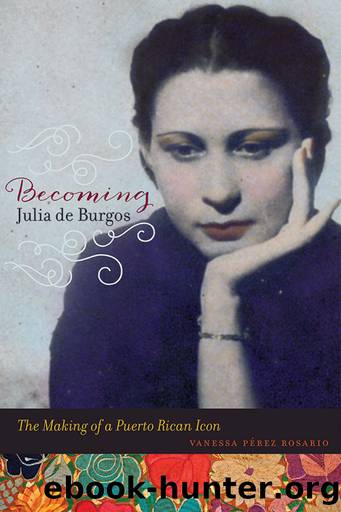Becoming Julia de Burgos by Vanessa Perez Rosario

Author:Vanessa Perez Rosario
Language: eng
Format: epub
Publisher: University of Illinois Press
Published: 2014-01-15T00:00:00+00:00
5
REMEMBERING JULIA DE BURGOS
Cultural Icon, Community, Belonging
Sites of memoryâarchives, museums, works of art, monuments, anniversaries, ritualsâare fundamentally created, Pierre Nora says, âto stop time, to block the work of forgetting, to establish a state of things, to immortalize death, to materialize the immaterial.â Without the will to remember, history would soon sweep away these memories. Mass culture and the media toss aside memory in exchange for an endless film of current events. Sites of memory represent an attempt to capture a maximum of meaning in the fewest signs; these sites exist because of their âcapacity for metamorphosis, an endless recycling of their meaning and an unpredictable proliferation of their ramifications.â Sites of memory help mediate a relationship to the past that is formed of a âsubtle play between its intractability and its disappearance.â We seek an understanding of what we are in light of what we are no longer.1 In the act of remembering Julia de Burgos, visual artists are less concerned with finding the âtrueâ Julia; rather, they create sites of memory that are at once collective and individual, mediating our relationship to the past, the present, and the future.
Two distinct historical moments have provided fertile ground for reading Burgos as a historical figure, a writer, and a cultural icon. First, as part of the civil rights movement of the 1960s, women of color sought to correct the elisions and omissions of writers, artists, and intellectuals of color in the historical records and the literary canon, Latina writers reclaimed Burgos and struggled to have her recognized in literary history. Second, during the âLatin explosionâ of the 1990s, signaled by the 12 July 1999 issue of Newsweek with its cover story âLatino U.S.A.,â corporate marketers came to understand Latinos as a consumer category. Simultaneously, anti-immigration sentiment and widespread anxiety about the U.S.-Mexican border swept the United States.
The 1990s witnessed the cultural and commercial iconization of Frida Kahlo and of Eva Duarte Perón, two Latin American women who died tragically at a young age. Selena Quintanilla, a young Latina superstar from Texas, was murdered in 1995 and became lionized across the United States. In her book on Selena, Deborah Paredez notes that in the 1990s, despite the different investments in Latinidad, all constituencies, whether cultural or commercial, evoked the symbol of the dead Latina, which was âfrequently pressed into service by a range of communities to claim or to contest the political, cultural, or economic force of Latinidad.â2 Frida, Evita, Selena, and Julia have been remembered and immortalized in plays, performances, music, biographies, films, murals, paintings, stories, and novels, among other genres. Hollywood made films about the first three icons, no last names required: Madonna played Evita (1996), Jennifer Lopez played Selena (1997), and Salma Hayek played Frida (2002). Burgos, however, has not achieved the same level of mainstream commercial success and visibility. In part, this phenomenon results from the fact that Kahlo, as a visual artist, and Selena, as a pop star, do not rely exclusively on language to communicate their art.
Download
This site does not store any files on its server. We only index and link to content provided by other sites. Please contact the content providers to delete copyright contents if any and email us, we'll remove relevant links or contents immediately.
4 3 2 1: A Novel by Paul Auster(11822)
The handmaid's tale by Margaret Atwood(7471)
Giovanni's Room by James Baldwin(6830)
Asking the Right Questions: A Guide to Critical Thinking by M. Neil Browne & Stuart M. Keeley(5370)
Big Magic: Creative Living Beyond Fear by Elizabeth Gilbert(5364)
Ego Is the Enemy by Ryan Holiday(4971)
On Writing A Memoir of the Craft by Stephen King(4676)
The Body: A Guide for Occupants by Bill Bryson(4603)
Ken Follett - World without end by Ken Follett(4453)
Bluets by Maggie Nelson(4283)
Adulting by Kelly Williams Brown(4246)
Eat That Frog! by Brian Tracy(4171)
Guilty Pleasures by Laurell K Hamilton(4128)
White Noise - A Novel by Don DeLillo(3838)
The Poetry of Pablo Neruda by Pablo Neruda(3828)
Fingerprints of the Gods by Graham Hancock(3749)
Alive: The Story of the Andes Survivors by Piers Paul Read(3743)
The Book of Joy by Dalai Lama(3713)
The Bookshop by Penelope Fitzgerald(3628)
